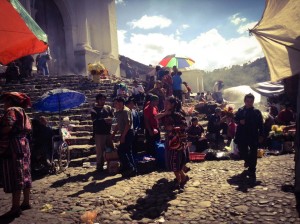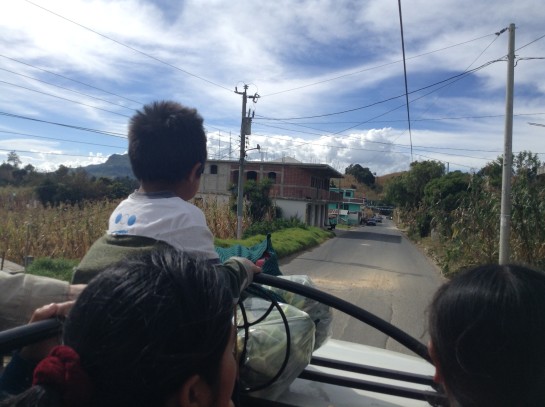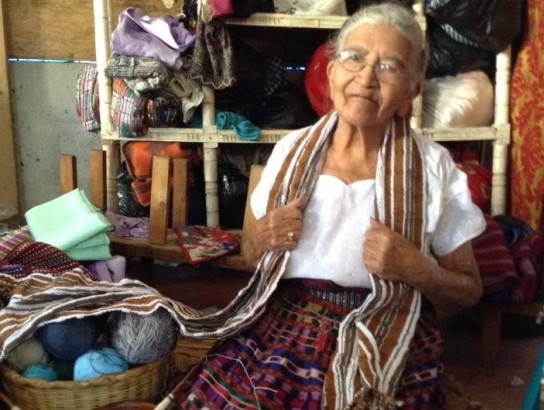 When you first arrive at Lake Atitlan, you most likely land in Panajachel, the tourism heart of Atitlan. Storefronts, vendors, art galleries, and restaurants draw you in with their brightly colored tapestries, ethnic foods, and photographs of dirty, starving children with snot covering their noses and big, brown eyes that just make you want to pinch their chubby cheeks and coo at them. This is the advertiser’s Atitlan.
When you first arrive at Lake Atitlan, you most likely land in Panajachel, the tourism heart of Atitlan. Storefronts, vendors, art galleries, and restaurants draw you in with their brightly colored tapestries, ethnic foods, and photographs of dirty, starving children with snot covering their noses and big, brown eyes that just make you want to pinch their chubby cheeks and coo at them. This is the advertiser’s Atitlan.
Travel agencies offer to take you on luxurious boat rides around the lake, visiting the towns of San Juan, Santa Catarina, and San Antonio Palopo, where women and children are waiting with hand-made pottery and wood carvings that will look absolutely stunning on your mantel back home.
You venture to San Pedro, where signs written in Hebrew and English advertise food and lodging with optional massages and Spanish classes. The white, dreadlocked faces of San Marcos draw you into their peaceful serenity of meditation and yoga, brought all the way to Atitlan from the heart of India. And you stop by Jaibalito on the way home because you’ve heard that a restaurant there cooks the best hamburgers in Guatemala.
And then you go back to your hostel and connect to the free wifi for a bit before hitting the bars and dancing to some good ol’ Avicii.
 Honestly, many of my weekends in Guatemala were spend in this very fashion – and with my fellow gringos keeping me company. And, don’t get me wrong, it’s a blast. Atitlan offers a unique melting pot of travelers from all over the world, all searching for different experiences and sharing them with one another. But this is the tourist’s Atitlan. An entirely different world exists behind the storefronts on Calle Santander: the real Mayan culture of Lago de Atitlan.
Honestly, many of my weekends in Guatemala were spend in this very fashion – and with my fellow gringos keeping me company. And, don’t get me wrong, it’s a blast. Atitlan offers a unique melting pot of travelers from all over the world, all searching for different experiences and sharing them with one another. But this is the tourist’s Atitlan. An entirely different world exists behind the storefronts on Calle Santander: the real Mayan culture of Lago de Atitlan.
When travelers visit the lake, it’s hard for them to believe that it houses some of the most crippling poverty in all of Guatemala. But I challenge you to take a step off of the tuk-tuk driven path, and venture down a road without ATMs.
For example, catch a pick-up truck on the outskirts of Panajachel and take it to the small town of San Andres, where you will find a community surrounded by corn fields, dirt roads, and sweat. One church stands in the center of town, along with a handful of failing public schools. Fathers work in the fields from dusk till dawn, and mothers stay at home and care for the children. Boys seldom study past the second grade, once they’ve developed enough strength to help their fathers harvest crops. Girls—if their parents enroll them in school at all—drop out around the same time to help their mothers cook and clean and care for their siblings.

Or walk up the road about a half mile from the center of San Marcos. Wander up the winding dirt paths that pass torillerías, more corn fields, and baskets of fruit set on front porches. There are no restaurants, no internet cafés. Only people working, cooking, playing, and staring open-mouthed at you because you are the only tourist in weeks who has ventured up past the streetlamps.
This is the Atitlan that I fell in love with. The cornfields, the dirt roads, the elderly women who throw their hands up in the air and laugh as the pickup truck rounds a bend at high-speed. The 8-year-old girls who hug their baby brothers to their chests as they sweep the step in front of their homes. The homes, which are made of four pieces of sheet wood nailed together with a slab of tin on top. And they wouldn’t give up their tin roofs for the world, because nothing beats the pattering of the rain as they fall asleep.
So here’s my challenge to you: take the tuk-tuk to the end of the road. Then get out. Walk until you can’t hear the sound of the cars anymore. Look up. Meet someone’s eyes. Smile.
You are looking at the true Atitlan.